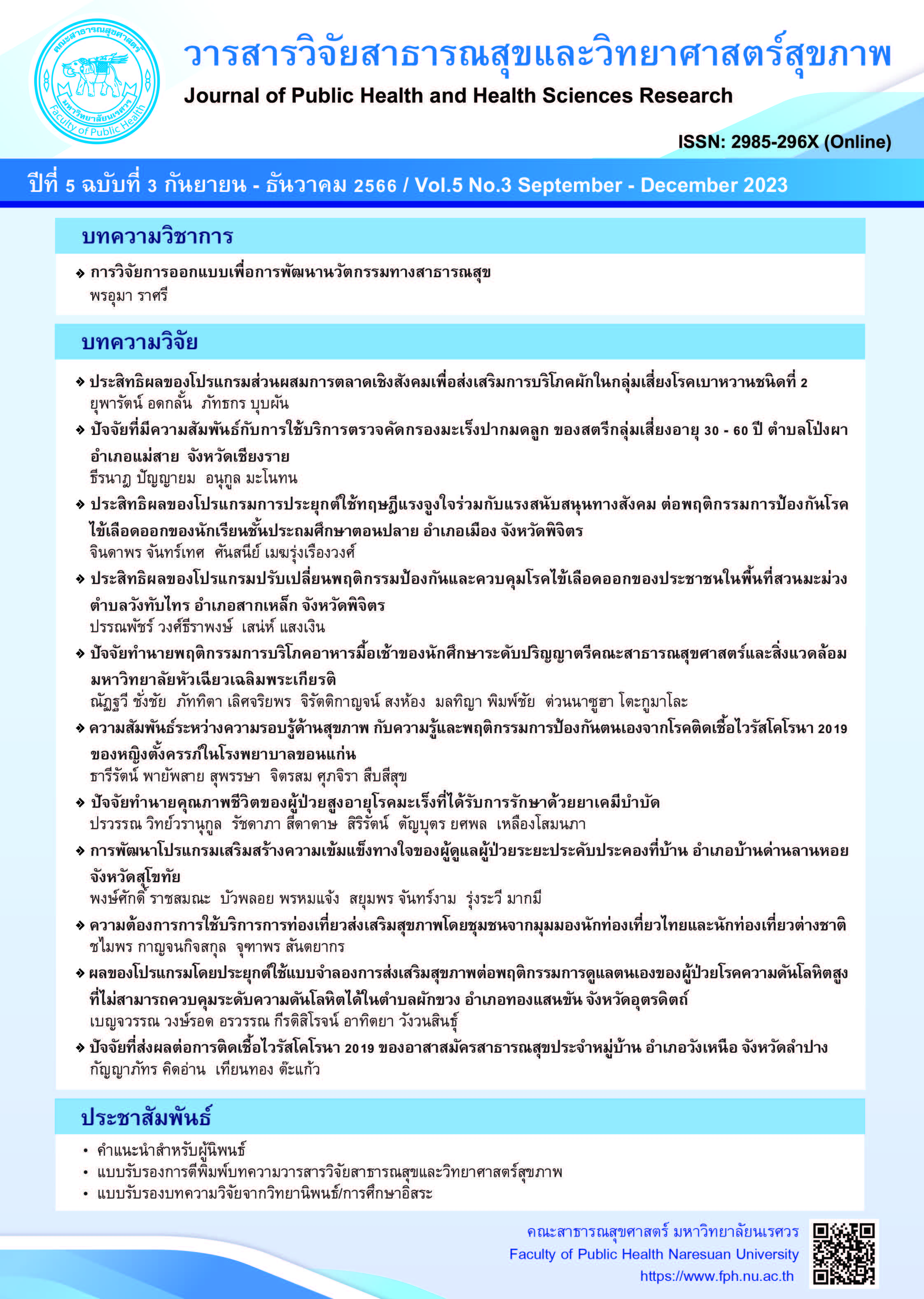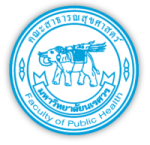The demand for community-based wellness tourism services from the perspective of Thai and foreign tourists
Keywords:
Wellness tourism, Community-based wellness tourism, Demand tourists, Tourism servicesAbstract
Wellness tourism is a form of tourism that links individual health with social aspects and considers individual lifestyles. The objective of this research was to explore the demand for community-based wellness tourism services from Thai and foreign tourists' points of view. The study sample was 409 cases of Thai and foreign tourists aged 20 or over. The study tool was the online questionnaires and descriptive statistics such as frequency and percentage were used.
The results of the study revealed that the demand for services could be categorized into three dimensions: tourism behavior, service activities, and standards/safety in the environment. In the tourism behavior dimension, it was found that Thai tourists (97.5%) and foreign tourists (78.5%) shared a common interest in traveling primarily for physical and mental relaxation. In the service activities dimension, the preferences differed slightly. For Thai tourists, the top five areas of highest demand included music (70.6%), hot springs (62.3%), visiting community landmarks (57.4%), massage (55.4%), and arts/performing (54.9%). In contrast, foreign tourists had a preference for craft learning activities (63.9%), healthy food (61.5%), local cooking demonstrations (61.0%), alternative medicine (60.5%), and music (58.5%) and hot springs (58.5%). Lastly, the dimension of the standards and safety in the environment, Thai tourists prioritize accident safety (70.5%), epidemic prevention and control (67.5%), emergency medical services (60.9%), emergency care (55.7%), and the cleanliness of services (51.0%). Foreign tourists, on the other hand, placed the highest demand on epidemic prevention and control (76.1%), emergency medical services (74.6%), cleanliness of various services (61.5%), safety from deception/fraud (53.2%), and accident safety (52.7%). The stakeholders should develop community-based health promotion tourism in line with the needs of tourists.
References
Abdullah, M., Ali, N., Hussain, SA., Aslam, AB. & Javid, MA. (2021). Measuring changes in travel behavior pattern due to COVID-19 in a developing country: A case study of Pakistan. Transport Policy, 108(c), 21-33.
Academic office, the Secretariat of the House of Representatives. (2019). "Tourism safety measures". Electronic academic papers. Retrieved April 8, 2022, from https://www. parliament.go.th/ewtadmin/ewt/parliament_parcy/ewt_dl_link.php?nid=56340&filename=index. (in Thai)
Artharn, D., Jaroenwisan, K., and Boonmeesrisanga, M. (2022).The enhancement of safety and health protocols for sustainable homestay tourism after the COVID-19 pandemic in Thailand. Journal of Liberal Arts Thammasat University, 22(1), 186-204. (in Thai)
Economics Tourism and Sports Division, Ministry of Tourism and Sports. (2019). "Safe tourism: Thailand tourism situation quarter 1/2019 and quarter 2/2019". Tourism Economic Conditions Report. Retrieved April 8, 2022, from https://www.mots.go.th/download/article/article_20191025094442.pdf. (in Thai)
Eiamnakha, N., Nisamaneepong, J., Panla-Or, P., Senglum, C. and Poosanam, W. (2021). "To the health path in Thailand: The journey to Thailand health tourism ep.1". Retrieved June 21, 2023, from http://mrd-hss.moph.go.th/mrd1_hss/wp-content/uploads/2021/09/The-Journey-To-Thailand-Health-Tourism-EP.1.pdf. (in Thai)
Heranya, M. (2564). Wellness tourism behavior of Thai tourists in Chiang Mai. Sarasatr, 4(3), 664-677. (in Thai)
Kaewkiriya, B. and Buchain, R. (2021). Factors influencing foreign tourist's decision to select a hostel in Bangkok. Journal of Thai Hospitality and Tourism, 16(1), 3-11. (in Thai)
Kanchanakijsakul, C. (2013). "Research methodology in social sciences". 2nd. Tak: Project five-four. (in Thai)
Kladkaew, N. and Parkobkit, S. (2019). Developing Thailand as a creative tourism hub for Muslim tourists in ASEAN: Case study Phuket Province. Journal of Sustainable Tourism Development, 1(1), 50-70. (in Thai)
Krajangchom S., and Sangkakorn K. (2020). Behaviors and needs of Thai and Foreign wellness tourists in Upper North of Thailand. University of the Thai Chamber of Commerce Journal, 40(1), 57-76.
Liao, C., Zuo, Y., Xu, S., Law, R. & Zhang, M. (2023). Dimensions of the health benefits of wellness tourism: A review. Frontiers in Psychology, 13:1071578. https://doi: 10.3389/fpsyg.2022.1071578.
Lo, Y-C. & Janta, P. (2020). Resident's perspective on developing community-based tourism-A qualitative study of Muen Ngoen Kong community, Chiang Mai, Thailand. Frontiers in Psychology, 11:1493. https://doi: 10.3389/fpsyg.2020.01493.
Madhyhamapurush, W. (2013). Tourism marketing for long stay Japanese pensioner tourists in Chiang Mai. Journal of Thai Hospitality and Tourism, 8(2), 48-61. (in Thai)
Manirochana, N. (2017). Community based tourism management. International Thai Tourism Journal, 13(2), 25-46.
Manirochana, N. (2021). Potential development of hot spring destination at Ban Nong Charoen Kanchanaburi province for high value tourism. Journal of Philosophical Vision, 26(1), 146-171. (in Thai)
Marohabutr, T. (2018). Medical hub policy strategy and situations reflecting impact on the health system of Thailand. Quality of Life and Law Journal, 14(2), 27-41. (in Thai)
Ministry of Tourism and sports. (n.d.). "Handbook of quality standard assessment in health tourism sources of natural hot springs". 2nd, Office of tourism development, Department of tourism. Retrieved April 8, 2022, from https://www.dot.go.th/ebooks/ebooks-view/429. (in Thai)
Niemchai S., Taweepol R., Sirichodnisakorn C. (2021). The efficiency driving of wellness service of wellness homestay in Thailand. MFU Connexion: Journal of Humanities and Social Sciences, 10(2), 93-111. (in Thai)
Office of the Permanent Secretary, Ministry of Tourism and Sports. (2019). Safety tourism: Situation of Thai tourism. Tourism economic review, 1. 12-20.Office of the Permanent Secretary, Bangkok. Retrieved April 8, 2022, from https://www.mots.go.th/download/article/article_20191025094442.pdf
Rattanapichit, N., Keawood, R., and Nuang-uthai, T. (2018). "Factors influencing the elderly's health tourism behavior in Nakhon Si Thammarat Province". Research Report. The Faculty of Science and Technology, Rajamangala University of Technology Srivijaya, Songkhla. (in Thai)
Royal Institute. (2003). "Dictionary, Royal Institute Edition, 1999". Bangkok: Nanmeebooks Publication Co., Ltd., (in Thai)
Saenkam, B. (2021). The behavior of Thai tourists after COVID 19 situations. Journal of Liberal Arts and Service Industry, 4(1), 160-167.
Suansri, P. (2003). "Community based tourism handbook". Tourism for Life and Nature Project.Bangkok: Responsible Ecological Social Tour. (in Thai)
Sukjairungwattana, T. (2018). Paradigm of alternative flow: Strategies to drive creative economy in Thai society. Veridian E-Journal, Silpakorn University (Humanities, Social Sciences and arts), 11 (1), 411-427. (in Thai)
Ullah, N., Zada, S.,Siddique, MA., Hu, Y., Han, H., Vega-Munoz, A., & Salazar-Sepulveda, G. (2021). Driving factors of the health and wellness tourism industry: A sharing economy perspective evidence from KPK Pakistan. Sustainability, 13(23), 13344. https://doi: 10.3390/su132313344.
Downloads
Published
How to Cite
Issue
Section
License
Copyright (c) 2023 Journal of Public Health and Health Sciences Research

This work is licensed under a Creative Commons Attribution-NonCommercial-NoDerivatives 4.0 International License.
The published article is copyrighted by the Journal of Public Health and Health Sciences Research.
The statements that appear in each article in this academic and research journal are the personal opinions of each author and are not related to Naresuan University and other faculty members in the university. Responsibilities regarding each article are the responsibility of each author.






